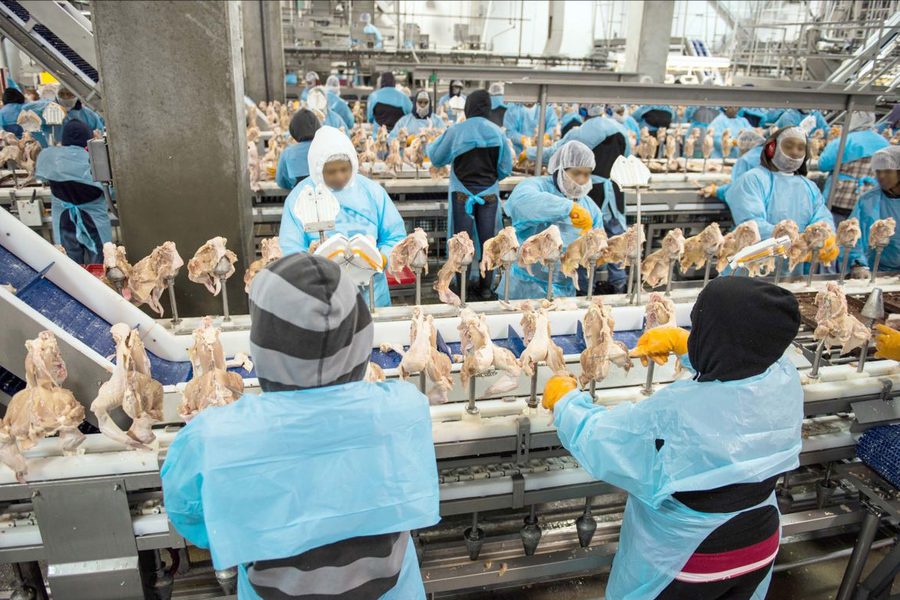From Amputations to Respiratory Illnesses, New Report Exposes Hazards of Slaughterhouse Work
Anna Casey

This story was originally published by the The Midwest Center for Investigative Reporting.
Repetitive motion injuries, amputations and cuts continue to be common dangers that workers in the meat processing industry face, according to a Government Accountability Office report released this month.
The GAO also found workers suffer respiratory illnesses from peracetic acid – an antimicrobial chemical – sprayed on meat in processing facilities. In addition, investigators from GAO identified a lack of bathroom access as a major concern among workers – one that workers were afraid to mention to federal labor inspectors at plants for fear of retribution from their employer.
The report reviewed the government’s efforts – specifically the Department of Labor’s Occupational Health and Safety Administration (OSHA) – to protect the health and safety of workers in the nation’s animal slaughtering and processing industry, one of the most hazardous industries in the U.S.
Approximately 72 workers were interviewed in Arkansas, Delaware, Nebraska, North Carolina and Virginia. Workers in three of those states said they had suffered negative health effects, such as kidney problems, from delayed or denied bathroom breaks. One industry representative said some supervisors in meat and poultry plants restricted bathroom access in order to maximize production output, according to the report.
“When asked by GAO, workers in five selected states cited bathroom access as a concern and said they fear speaking up at work,” the report stated.
OSHA sets safety standards and plays a role in establishing and enforcing regulations that affect the health of the estimated 480,000 people in the U.S. meat and poultry processing industry. The department increased inspections from 177 in 2005 to 244 in 2016, but the government still faced challenges identifying and addressing concerns of workers.
GAO found that employees at some plants feared penalties for coming forward with injuries sustained on the job. Cuts, repetitive motion injuries, and amputations occur from hand saws, knives and other manual tools, but the report found that the accessibility of first aid stations, and the expertise of on-site medical professionals was lacking at several facilities, according to interviews conducted with Department of Labor officials.
One poultry plant employee visited an on-site medical professional over the course of three months for severe pain in her wrist. During this time, she continued to work until she was referred to another doctor affiliated with the company who didn’t find a problem. She later, “went to a doctor unaffiliated with the plant, who found a bone fracture,” according to the report.
Based on its findings, the GAO outlined seven recommendations to the Department of Labor’s Occupational Safety and Health Administration, including steps to encourage workers to come forward about sensitive concerns by conducting off-site interviews, and updating guidelines for employers on how to better manage their health units.
Worker-advocacy nonprofit Oxfam welcomed the GAO report, and said in a statement that it confirmed findings from studies they had conducted in 2015 and 2016 into the safety of the meat processing industry.
“The central underlying problem is the pervasive climate of fear inside poultry plants; when workers are afraid to report issues, OSHA and other inspection agencies are unable to detect or investigate problems,” Oxfam said in a statement.
While specific companies were not named in the report, Virginia-based Smithfield Foods, which employs about 34,000 people in pork processing and packaging jobs, said that their injury rates were below the national average, due in part to an employee engagement effort “that encourages employees to play an even more active role in communicating, training and implementing” Smithfield’s safety-management program, said Karen Lombardo, Senior Vice President of Corporate Affairs at Smithfield. The company’s workplace health and safety violations declined from 67 in 2012 to 29 last year, according to its annual report.
Seaboard Foods, a Kansas pork producer, received the most fines of any food company for OSHA violations in 2017, according to the most recently available data from Good Jobs First. The violations, for things such as improper guarding on tools, occurred at the company’s plant in Guymon, Oklahoma. The initial fines totaled more than $100,000, indicating the seriousness of the penalty, but not necessarily the amount the company ultimately had to pay.
In a response to GAO’s report, trade groups representing the U.S. poultry processing industry said they had made significant progress in reducing injury and illness rates in recent decades, and that they would continue to work toward safer environments for employees.
“While GAO’s recommendations pertain to OSHA, FSIS and NIOSH, we look forward to reviewing the report and recommendations in detail to determine if they will have a meaningful outcome in helping to continue the progress we’ve made in keeping our employees safe,” said Tom Super, a representative for the National Chicken Council, National Turkey Federation and U.S. Poultry & Egg Association.
A 2016 GAO report found that injury and illness rates among workers in meat and poultry processing plants has declined steadily since 2004, part of an overall trend across manufacturing industries, but that meat and poultry processing remained one of the most hazardous occupations for U.S. workers.
The Midwest Center for Investigative Reporting is a nonprofit, online newsroom offering investigative and enterprise coverage of agribusiness, Big Ag and related issues through data analysis, visualizations, in-depth reports and interactive web tools. Visit us online at www.investigatemidwest.org.

I hope you found this article important. Before you leave, I want to ask you to consider supporting our work with a donation. In These Times needs readers like you to help sustain our mission. We don’t depend on—or want—corporate advertising or deep-pocketed billionaires to fund our journalism. We’re supported by you, the reader, so we can focus on covering the issues that matter most to the progressive movement without fear or compromise.
Our work isn’t hidden behind a paywall because of people like you who support our journalism. We want to keep it that way. If you value the work we do and the movements we cover, please consider donating to In These Times.



